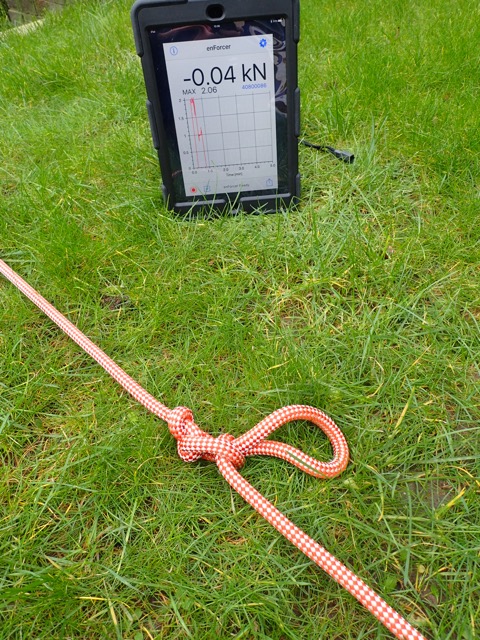One of the things that came up on a recent training course was a conversation regarding the different knots used in rigging a traverse line. I’ve always taught the Alpine Butterfly as a preferred knot, but I know others teach different knots.
Those working though (or having competed) their MIA (Mountain Instructor Award) often come along and tie an overhand knot on a traverses. Others advocate a “Caver’s Butterfly” or sometimes called a Truckers Knot, tied by a slip knot with another hitch dropped over the top. This has the advantage of being easy to tie, and easy to adjust so you can get the knot in the right place.
I’ve always been a little sceptical about the “Caver’s Butterfly” having looked at how it deforms when pulled apart, so I thought I’d do a little bit of testing. Here’s the results of round one…
Personal observations
Each knot was tied snug but not as tight as you’d probably tie in use. I tried to hold around 1kN of force on the knot for roughly 10 seconds then up to 2kN for another 10 seconds.
Clearly the overhand knot rotates and slips on a 1kN load (that’s roughly the weight of a large adult so realistically achievable in use), it continued to rotate a little with another 2kN.
The Alpine Butterfly seemed to sinch up on loading then appeared to hold with very little slippage.
The Truckers Knot/Cavers Hitch clearly deformed as soon as a load was placed on it. It continued to deform with a greater load.
So what’s this mean?
Well if a knot deforms significantly when loaded it means the initial rigging (sharing of multiple anchors for example) is compromised. This could result in single anchors being loaded at pitch heads for example, and potentially exposing anchors to a shock load, and that’s before we start to consider the friction or any possible increased strain on a section of rope. Is this a big deal? I’ll leave it to you to decide!
Worth also noting all knots were relatively easy to untie after use, and there wasn’t any significant compression or visible damage to the rope.
Additional notes
I only managed to achieve a little over 2kN in testing in my back garden. With just one person hauling (and being a little anxious about pulling my fence down!) I couldn’t test to higher loads. So I popped into work and tied the rope to a tree and the back of the van to try and achieve higher loads! I tested an overhand knot first up to 3.5kN, when it started to rain. Filming proved problematic not really getting a good clear image. However when untying afterwards the overhand knot untied relatively easily, as did the figure of eight around the van. However the double fisherman’s I used to tie a sling around a tree with a short length of 11mm semi-static was impossible to undo! Something to bear in mind.
Gethin
23rd January 2016

